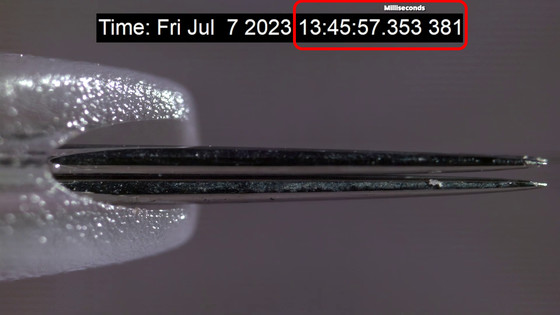It looks like this when a tattoo needle engraves ink on the skin with a high speed camera of 20,000 fps

Tattoos are made by injuring the skin with a needle and at the same time injecting ink to draw various patterns and letters on the body. To engrave a tattoo, I use a tattoo gun that shoots out a needle at a speed that can not be seen, but various images captured in slow motion how this tattoo gun engraves ink into the skin.
Tattoo on Transparent 'Skin' at 20,000fps-The Slow Mo Guys-YouTube
Place the prepared tattoo gun in front of the high-speed camera and move it.

Taking a picture of the tip of the tattoo gun looks like this. Displayed above is the date and time the image was captured, measured to the nearest millionth of a second. Since the video shot at 20,000 fps with a high speed camera is played back at 50 fps, it will be played back 400 times slower.

It takes about 3 milliseconds for the needle to reach its maximum length. In other words, it takes only about 6 milliseconds for the needle to make one reciprocation, and the needle of the tattoo gun pops out about 160 to 170 times per second.

Next time I will let the ink bleed and shoot out the needle.

Looking at the needle that pops out with the smeared ink, 'It looks like an alien's mouth,' said The Slow Mo Guy.

Next, let's engrave the ink with a tattoo gun into the ballistic gelatin used to observe the behavior when the bullet hits the human body. Ballistic gelatin has elasticity close to animal muscle tissue and is transparent, so you can observe how the tattoo gun engraves the ink.

The needle sticks into the ballistic gelatin.

You can see that the ink clinging to the needle remains in the ballistic gelatin and soaks into the needle.

If you move the tattoo gun as it is, a needle-like ink will be engraved into the ballistic gelatin along the trajectory of the tattoo gun.

A side view of the needle of the tattoo gun sticking into the ballistic gelatin.

When the needle is deeply pierced, the ink clinging to the needle sticks to the ballistic gelatin, and when you look at the tip, the needle is clean.

And when the needle is pulled out, the ink remains in the sting marks of the needle.

This time, change the ink to red and shoot facing the direction where the needle sticks. The focus is not on the needle, but on the inside of the ballistic gelatin, slightly in front of the needle.

A needle dyed in red ink is visible through the transparent ballistic gelatin.

It feels like this when the needle pierces deeply. Ink remains firmly in the in-focus position.

In this experiment, we used ballistic gelatin, not real skin. The Slow Mo Guy commented, 'If you use it on the skin, you'll need to go deeper.'

Ballistic gelatin engraved with a tattoo looks like this.

The ink is engraved to a depth of only a few millimeters.

Daniel Grucci (right) of The Slow Mo Guy commented, ``I've said it before, but when I see this video, I still don't want to get a tattoo.''

Related Posts:
in Video, Posted by log1i_yk







